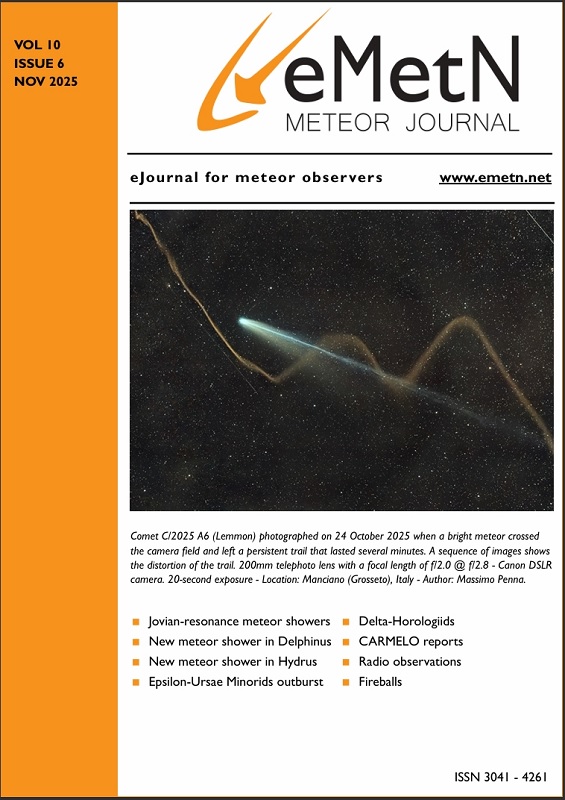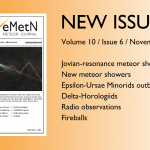During this period, the Moon reaches its new phase on Tuesday, October 21st. On that date, the Moon will be located near the Sun and will be invisible at night. As the week progresses, the waxing crescent Moon will enter the evening sky but will not interfere with meteor observing.
The estimated total hourly rates for evening observers this weekend should be near 4 as seen from mid-northern latitudes (45°N) and 3 as seen from tropical southern locations (25°S). For morning observers, the estimated total hourly rates should be near 25 as seen from mid-northern latitudes (45°N) and 20 as seen from tropical southern locations (25°S).
The actual rates observed will also depend on factors such as personal light and motion perception, local weather conditions, alertness, and experience in watching meteor activity. Note that the hourly rates listed below are estimates based on observations from dark-sky sites away from urban light sources. Observers viewing from urban areas will see less activity, as only the brighter meteors will be visible from such locations.
The radiant (the area of the sky from which meteors appear to originate) positions and rates listed below are exact for Saturday night/Sunday morning, October 18/19. These positions do not change greatly from day to day, so the listed coordinates may be used throughout this entire period. Most star atlases (available online, in bookstores, and at planetariums) include maps with celestial coordinate grids that can help you locate these positions in the sky.
I have also included charts of the sky that display the radiant positions for evening, midnight, and morning. The center of each chart represents the sky directly overhead at the corresponding hour. These charts are oriented for facing south but can be used for any direction by rotating them accordingly. A planisphere or computer planetarium program is also useful for showing the sky at any time of night on any date of the year.
Activity from each radiant is best seen when it is positioned highest in the sky (culmination), either due north or south along the meridian, depending on your latitude. Radiants that rise after midnight will not reach their highest point in the sky until daylight; therefore, it is best to view them during the last few hours before dawn.
It must be remembered that meteor activity is rarely seen directly at the radiant position. Rather, meteors shoot outward from the radiant, so it is best to center your field of view so that the radiant lies near the edge rather than the center. Viewing in this way allows you to trace the path of each meteor back to the radiant (if it belongs to a shower) or in another direction if it is sporadic. Meteor activity is not visible from radiants located far below the horizon.
The positions below are listed in west-to-east order by right ascension (celestial longitude). The positions listed first are located farther west and are therefore accessible earlier in the night, while those listed farther down the list rise later.
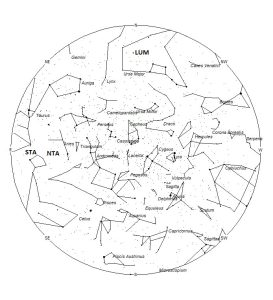
Radiant Positions at 20:00 LST
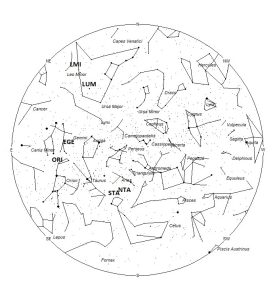
Radiant Positions at 01:00 LST
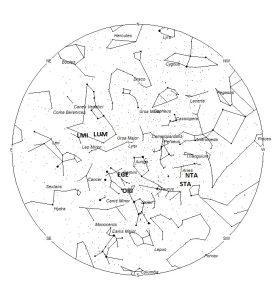
Radiant Positions at 05:00 LST
These sources of meteoric activity are expected to be active this week
The Northern Taurids (NTA) should be active from a wide radiant located at 02:31 (041) +18. This area of the sky lies in central Aries, about 6 degrees southeast of the 2nd-magnitude star Hamal (Alpha Arietis). To best see these meteors, observers should face southward near 02:00 local summer time (LST). To differentiate between the Northern and Southern Taurids, face toward these radiants, as they lie close together in the sky. Maximum activity is not expected until November 9th, so rates at this time should be less than 1 per hour, regardless of location. With an entry velocity of 31 km/sec, the average NTA meteor would be of medium-slow velocity.
The wide radiant for the Southern Taurids (STA) is centered near 02:56 (044) +13. This area of the sky lies in southeastern Aries, about 5 degrees southwest of the 4th-magnitude star 41 Arietis. This radiant is best placed near 02:00 LST, when it lies on the meridian and is highest in the southern sky. Rates at this time should be near 3 per hour, regardless of location. With an entry velocity of 32 km/sec, the average STA meteor would also be of medium-slow velocity. Many fireballs from this source have already been reported this month, so monitoring this shower may be rewarding while the Moon is not interfering. These meteors are also known as the October Arietids during October.
The Orionids (ORI) are active from October 2 through November 12, with maximum activity occurring on October 23rd. The radiant is currently located at 06:16 (094) +16, which places it in northeastern Orion, about 9 degrees north of the 1st-magnitude star Betelgeuse (Alpha Orionis). This area of the sky is best placed for observing during the last dark hour before dawn, when it lies highest in the southern sky. Current rates are expected to be near 10 per hour this weekend, regardless of location. Rates are expected to increase to 15–20 meteors per hour by mid-week. With an entry velocity of 66 km/sec, the average ORI meteor would be of swift velocity.
The Epsilon Geminids (EGE) are active from October 1st through November 4th, with maximum activity occurring on October 16th. The radiant is currently located at 06:48 (102) +28, lying in northwestern Gemini, about 4 degrees northeast of the 3rd-magnitude star Mebsuta (Epsilon Geminorum). To best see these meteors, face south during the last few dark hours before dawn. Rates at this time should be less than 1 per hour, regardless of location. With an entry velocity of 68 km/sec, the average EGE meteor would be of swift velocity.
The Lambda Ursa Majorids (LUM) were discovered by Željko Andreić and the Croatian Meteor Network team, based on SonotaCo and CMN observations (SonotaCo 2007–2011, CMN 2007–2010). These meteors are active from October 18 through November 7, with maximum activity on October 28th. The current location of the LUM radiant lies near 09:52 (148) +53, in southern Ursa Major, about 2 degrees northeast of the 3rd-magnitude star Theta Ursae Majoris. This area of the sky is best observed during the last hour before dawn, when it lies highest above the northeastern horizon in a dark sky. Current rates should be less than 1 per hour, regardless of location. Due to the high northern location of this radiant, these meteors are difficult to see from the southern hemisphere. With an entry velocity of 61 km/sec, most activity from this radiant would be of medium-fast speed.
The Leonis Minorids (LMI) are active from October 16th to November 6th, with maximum activity occurring on October 22nd. The radiant is currently located at 10:28 (157) +38, which places it in northeastern Leo Minor, about 3 degrees northeast of the 4th-magnitude star Beta Leonis Minoris. These meteors are best seen by facing east during the last couple of hours before dawn. This shower favors observers in the northern hemisphere, where the radiant rises higher into the northeastern sky before morning twilight. Current rates should be near 2 per hour as seen from the northern hemisphere and 1 per hour as seen from south of the equator. At 62 km/sec, the average Leonis Minorid is medium-fast. From personal experience, this minor shower produces a high proportion of bright meteors.
Sporadic meteors are those that cannot be associated with any known meteor shower. All meteor showers evolve and disperse over time until they are no longer recognizable. Away from the peaks of major annual showers, these sporadic meteors make up the bulk of the activity seen each night.
As seen from the mid-northern hemisphere (45°N), one would expect to see approximately 10 sporadic meteors per hour during the last hour before dawn, from rural observing sites. Evening rates would be near 3 per hour. From tropical southern latitudes (25°S), morning rates would be around 7 per hour and 2 per hour during the evening. Locations between these two extremes would experience activity between these figures. Evening rates are reduced due to moonlight.
The list below provides tabular information on the active showers that are within reach of the visual observer to discern. Hourly rates are often less than one, so these sources are rarely listed as visual targets in most meteor shower catalogs. If you, like me, wish to associate as many meteors as possible with known sources, you will appreciate these listings.
Before claiming to have observed meteors from these Class IV showers, you should determine whether they truly belong to them and are not chance alignments of sporadic meteors. Note parameters such as duration, length, radiant distance, and elevation of each meteor to help compute the probability of shower association.
It should be remembered that slow meteors can appear in fast showers, but fast meteors cannot be produced by slow showers. Slower showers are those with velocities less than 35 km/sec. Slow meteors can appear from fast showers when they occur close to the radiant or low in the sky.
The table located on page 22 of the IMO’s 2025 Meteor Shower Calendar is a helpful tool for identifying meteors. If you record the length and duration of each meteor, you can use this chart to check the probability of the meteor belonging to a shower of known velocity. If the angular velocity matches the figure in the table, your meteor probably belongs to that shower.
Recognizing meteors from obscure showers is not for beginning meteor observers—it takes many hours of practice to develop an instinct for what you’re seeing. It is our hope that you will move beyond simply watching meteors as a celestial fireworks display and help expand our knowledge of these heavenly visitors by classifying each meteor you observe.
Rates and positions in the table are exact for Saturday night/Sunday morning October 18/19.
| SHOWER | DATE OF MAXIMUM ACTIVITY | CELESTIAL POSITION | ENTRY VELOCITY | CULMINATION | HOURLY RATE | CLASS |
| RA (RA in Deg.) DEC | Km/Sec | Local Summer Time | North-South | |||
| Northern Taurids (NTA) | Nov 09 | 02:31 (041) +18 | 32 | 02:00 | <1 – <1 | II |
| Southern Taurids (STA) | Nov 05 | 02:56 (044) +13 | 31 | 02:00 | 3 – 3 | II |
| Orionids (ORI) | Oct 23 | 06:16 (094) +16 | 66 | 05:00 | 10 – 10 | I |
| epsilon Geminids (EGE) | Oct 16 | 06:48 (102) +28 | 68 | 05:00 | 1 – <1 | IV |
| Lambda Ursa Majorids (LUM) | Oct 28 | 09:52 (148) +53 | 61 | 08:00 | <1 – <1 | IV |
| Leonis Minorids (LMI) | Oct 22 | 10:28 (157) +38 | 62 | 09:00 | 2 – 1 | II |
You can keep track of the activity of these meteor showers as well as those beyond the limits of visual observing by visiting the NASA Meteor Shower Portal. You can move the sky globe to see different areas of the sky. Colored dots indicate shower meteors while white dots indicate sporadic (random) activity. The large orange disk indicates the position of the sun so little activity will be seen in that area of the sky.
Class Explanation: A scale to group meteor showers by their intensity:
- Class I: the strongest annual showers with Zenith Hourly Rates normally ten or better.
- Class II: reliable minor showers with ZHR’s normally two to ten.
- Class III: showers that do not provide annual activity. These showers are rarely active yet have the potential to produce a major display on occasion.
- Class IV: weak minor showers with ZHR’s rarely exceeding two. The study of these showers is best left to experienced observers who use plotting and angular velocity estimates to determine shower association. These weak showers are also good targets for video and photographic work. Observers with less experience are urged to limit their shower associations to showers with a rating of I to III.

